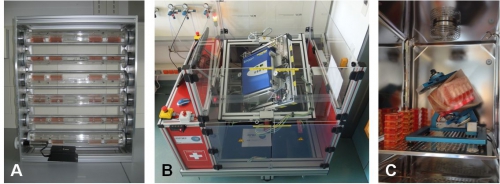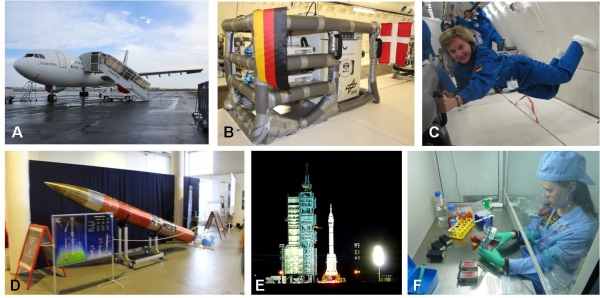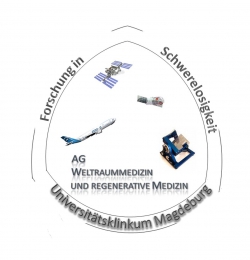Research
Space Biology and Bioscience
Our research group conducts research in the field of microgravity. We study thyroid tumor cells, endothelial cells and cartilage cells under the influence of simulated and real weightlessness. One way to simulate weightlessness on earth is the constant rotation of samples, which leads to a randomization of the gravity vector. Machines with which such a thing is possible are e.g. the clinostat (Rotation around one axis) and the Random Positioning Machine (RPM, rotation around two axes).) (Abb.1).

Abb. 1: Research possibilities with simulated weightlessness: A) schnell rotierender Klinostat (DLR, Köln), B) große RPM = Random Positioning Machine (Prof. Jörg Sekler FH Schweiz) und C) Desktop RPM (Dutch space, Airbus Defence and Space, Niederlande)
On parabolic flights, we have the opportunity to work with real weightlessness. We have 31 parabolas per flight day with 22 seconds of weightlessness each. During this time, not only the cells with which we work are exposed to weightlessness, but we researchers are also on board the aircraft and can experience weightlessness up close. (Abb. 2).
As part of larger research projects, we have already successfully sent cells into space for several days. In the SIMBOX project on the Chinese Shenzhou-8 and CELLBOX on the International Space Station (ISS), we were able to gain a deeper insight into the effect of weightlessness on cells. Significant changes in gene and protein expression were revealed. The cytoskeleton and cell growth were also affected. While cells usually grow as a flat cell turf in the laboratory on Earth, cells detached and formed spherical aggregates, so-called spheroids or tubular tubes, under both real and simulated weightlessness.

Abb. 2: Research opportunities in real weightlessness A) Parabolic flyer, converted A300 ZERO-G (Novespace, Bordeaux, Frankreich), B) our parabolic fugrack, C) our colleague Ganna Aleshcheva in the weightlessness phase of the parabolic flight ( 31 x 22 sec pro flight day), D) TEXUS rocket for experiments under up to 6 min. weightlessness, E) Shenzhou-8 rocket launch, F) our colleague Dr. Jessica Pietsch preparing the flight tests for Shenzhou-8.
The study of spheroids and tubes can potentially contribute to a reduction in animal testing in the production of new pharmaceuticals. New approaches in cancer research or in the reconstruction of vessels and tissues are further promising goals.
For the future, we are planning more experiments with simulated weightlessness on Earth, but also more parabolic flights, experiments on altitude rockets with up to 6 min weightlessness and more space flights like the SPHEROIDS project on the ISS.










